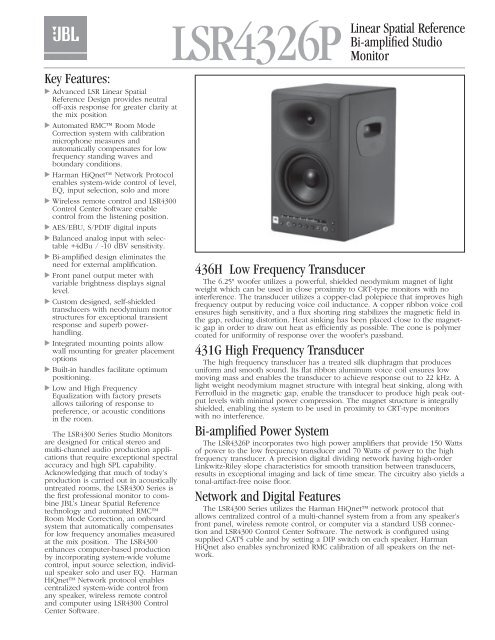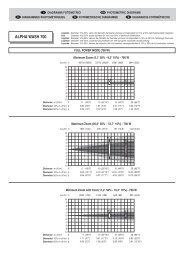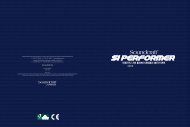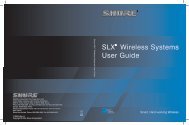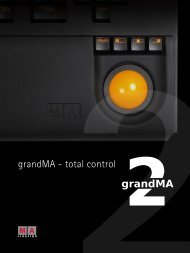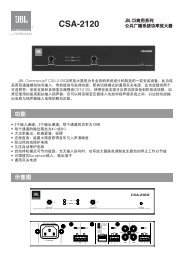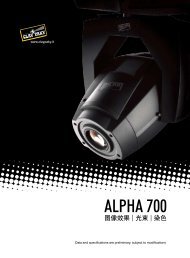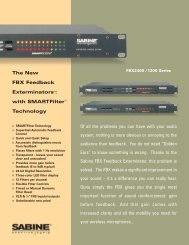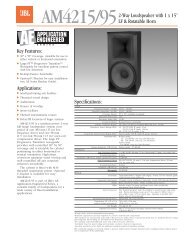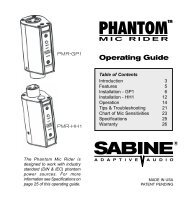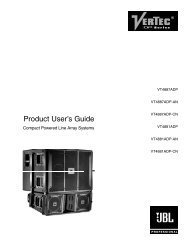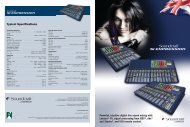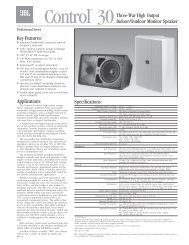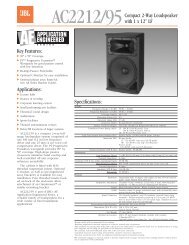LSR4326P Spec Sheet - JBL Professional
LSR4326P Spec Sheet - JBL Professional
LSR4326P Spec Sheet - JBL Professional
Create successful ePaper yourself
Turn your PDF publications into a flip-book with our unique Google optimized e-Paper software.
Key Features:<br />
Advanced LSR Linear Spatial<br />
Reference Design provides neutral<br />
off-axis response for greater clarity at<br />
the mix position<br />
Automated RMC Room Mode<br />
Correction system with calibration<br />
microphone measures and<br />
automatically compensates for low<br />
frequency standing waves and<br />
boundary conditions.<br />
Harman HiQnet Network Protocol<br />
enables system-wide control of level,<br />
EQ, input selection, solo and more<br />
Wireless remote control and LSR4300<br />
Control Center Software enable<br />
control from the listening position.<br />
AES/EBU, S/PDIF digital inputs<br />
Balanced analog input with selectable<br />
+4dBu / -10 dBV sensitivity.<br />
Bi-amplified design eliminates the<br />
need for external amplification.<br />
Front panel output meter with<br />
variable brightness displays signal<br />
level.<br />
Custom designed, self-shielded<br />
transducers with neodymium motor<br />
structures for exceptional transient<br />
response and superb powerhandling.<br />
Integrated mounting points allow<br />
wall mounting for greater placement<br />
options<br />
Built-in handles facilitate optimum<br />
positioning.<br />
Low and High Frequency<br />
Equalization with factory presets<br />
allows tailoring of response to<br />
preference, or acoustic conditions<br />
in the room.<br />
The LSR4300 Series Studio Monitors<br />
are designed for critical stereo and<br />
multi-channel audio production applications<br />
that require exceptional spectral<br />
accuracy and high SPL capability.<br />
Acknowledging that much of today’s<br />
production is carried out in acoustically<br />
untreated rooms, the LSR4300 Series is<br />
the first professional monitor to combine<br />
<strong>JBL</strong>’s Linear Spatial Reference<br />
technology and automated RMC<br />
Room Mode Correction, an onboard<br />
system that automatically compensates<br />
for low frequency anomalies measured<br />
at the mix position. The LSR4300<br />
enhances computer-based production<br />
by incorporating system-wide volume<br />
control, input source selection, individual<br />
speaker solo and user EQ. Harman<br />
HiQnet Network protocol enables<br />
centralized system-wide control from<br />
any speaker, wireless remote control<br />
and computer using LSR4300 Control<br />
Center Software.<br />
<strong>LSR4326P</strong><br />
Linear Spatial Reference<br />
Bi-amplified Studio<br />
Monitor<br />
436H Low Frequency Transducer<br />
The 6.25" woofer utilizes a powerful, shielded neodymium magnet of light<br />
weight which can be used in close proximity to CRT-type monitors with no<br />
interference. The transducer utilizes a copper-clad polepiece that improves high<br />
frequency output by reducing voice coil inductance. A copper ribbon voice coil<br />
ensures high sensitivity, and a flux shorting ring stabilizes the magnetic field in<br />
the gap, reducing distortion. Heat sinking has been placed close to the magnetic<br />
gap in order to draw out heat as efficiently as possible. The cone is polymer<br />
coated for uniformity of response over the woofer's passband.<br />
431G High Frequency Transducer<br />
The high frequency transducer has a treated silk diaphragm that produces<br />
uniform and smooth sound. Its flat ribbon aluminum voice coil ensures low<br />
moving mass and enables the transducer to achieve response out to 22 kHz. A<br />
light weight neodymium magnet structure with integral heat sinking, along with<br />
Ferrofluid in the magnetic gap, enable the transducer to produce high peak output<br />
levels with minimal power compression. The magnet structure is integrally<br />
shielded, enabling the system to be used in proximity to CRT-type monitors<br />
with no interference.<br />
Bi-amplified Power System<br />
The <strong>LSR4326P</strong> incorporates two high power amplifiers that provide 150 Watts<br />
of power to the low frequency transducer and 70 Watts of power to the high<br />
frequency transducer. A precision digital dividing network having high-order<br />
Linkwitz-Riley slope characteristics for smooth transition between transducers,<br />
results in exceptional imaging and lack of time smear. The circuitry also yields a<br />
tonal-artifact-free noise floor.<br />
Network and Digital Features<br />
The LSR4300 Series utilizes the Harman HiQnet network protocol that<br />
allows centralized control of a multi-channel system from a from any speaker’s<br />
front panel, wireless remote control, or computer via a standard USB connection<br />
and LSR4300 Control Center Software. The network is configured using<br />
supplied CAT5 cable and by setting a DIP switch on each speaker. Harman<br />
HiQnet also enables synchronized RMC calibration of all speakers on the network.
<strong>LSR4326P</strong> Linear Spatial Reference Bi-amplified Studio Monitor<br />
Automated RMC Room Mode Correction System<br />
Room modes” (sometimes called “standing waves”) can<br />
produce a low frequency resonance that gives a misleading<br />
impression of bass response at the listening position.<br />
RMC (short for “Room Mode Correction”) in the LSR4300<br />
series automatically analyzes the frequency response of<br />
the speakers at the listening position and automatically<br />
applies a corrective filter to minimize low frequency resonance.<br />
When the calibration mic is connected and the<br />
RMC analysis is initiated the LSR4300 RMC system applies<br />
a parametric filter at any of 73 frequencies (1/24th octave<br />
centers) between 20 Hz and 160 Hz, with a variable Q<br />
from 1 (1.4 octave bandwidth) to 16 (1/11th octave bandwidth),<br />
with 3 to 12 dB of attenuation.<br />
During the RMC calibration process, speaker levels are<br />
trimmed in 0.25 dB increments so that all speakers in the<br />
system produce equal SPL (sound pressure level) at the<br />
mix position.<br />
Linear Spatial Reference Design and Measurement Techniques<br />
We all know that many loudspeakers have similar measurements<br />
but sound different. By going beyond simple<br />
on-axis frequency response measurements, <strong>JBL</strong> defines the<br />
ultimate performance specification for new systems – what<br />
it will sound like in your room. While other manufacturers<br />
use a single on-axis frequency response measurement<br />
taken at one point in space, <strong>JBL</strong> measures monitor systems<br />
over a sphere that encompasses all power radiated<br />
into the listening room – in every direction. This data<br />
reflects 1296 times the information of a single on-axis<br />
response curve. Seventy-two measurements of the direct<br />
sound field, the reflected sound field, and the reverberant<br />
field, the entire sound field heard by the listener, is correlated<br />
to optimize response at the listening position. In<br />
place of spectral smoothing used by some manufacturers,<br />
which actually conceals data, the <strong>JBL</strong> approach actually<br />
exposes flaws in systems, such as resonances, poor dispersion<br />
and other causes of off-axis coloration. The data<br />
shown below is a set of spatially measured graphs that are<br />
the heart of <strong>JBL</strong>’s philosophy.<br />
<strong>LSR4326P</strong> Response Curves<br />
On Axis<br />
Window<br />
1st Reflection<br />
Sound Power<br />
DI_Sound Power<br />
DI_1st Reflection
<strong>Spec</strong>ifications:<br />
System:<br />
Frequency Response (+/- 1.5 dB): 55 Hz – 20 kHz<br />
Enclosure Rensonant Frequency: 52 Hz<br />
Low Frequency Extension: User controls set to default<br />
-3 dB: 47 Hz – 22 kHz<br />
-10 dB: 39 Hz – 32 kHz<br />
Low-High Frequency Crossover: Digital Crossover: 2.4 kHz, 8th order LR LF/4th order BW HF<br />
Distortion, 96 dB SPL,<br />
1 m: Mid-High Frequency<br />
(200 Hz - 20 kHz)<br />
2nd Harmonic:
<strong>LSR4326P</strong> Linear Spatial Reference Bi-amplified Studio Monitor<br />
Acoustic Contribution<br />
Phase and Amplitude<br />
96 dB/1 m (Distortion raised 20 dB)<br />
Impulse response<br />
102 dB/1 m (Distortion raised 20 dB)<br />
System Block Diagram<br />
LSR4300 Accessory Kit<br />
Includes:Wireless Remote Control, LSR4300 Control<br />
Center Software, RMC Calibration Microphone & Mic<br />
Clip, USB Cable, two AA Batteries, 2 Network<br />
Termination Plugs<br />
LSR4300 Control Center Software System<br />
Requirements:<br />
Windows:<br />
OS:Windows 2000, XP<br />
CPU: P3 500 MHz (1.0 GHz recommended)<br />
Macintosh:<br />
OS: OS X 10.3 or later<br />
CPU: 466 MHz or faster<br />
Hard Drive: 100 MB available<br />
RAM: 128 MB (512 MB recommended)<br />
USB Port<br />
<strong>JBL</strong> <strong>Professional</strong><br />
8500 Balboa Boulevard, P.O. Box 2200<br />
Northridge, California 91329 U.S.A.<br />
A Harman International Company<br />
© Copyright 2006 <strong>JBL</strong> <strong>Professional</strong><br />
SS <strong>LSR4326P</strong><br />
CRP 5M<br />
1/06


